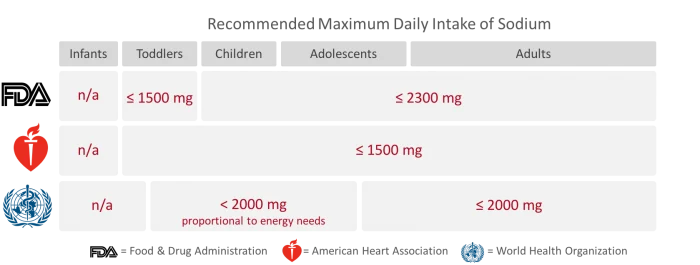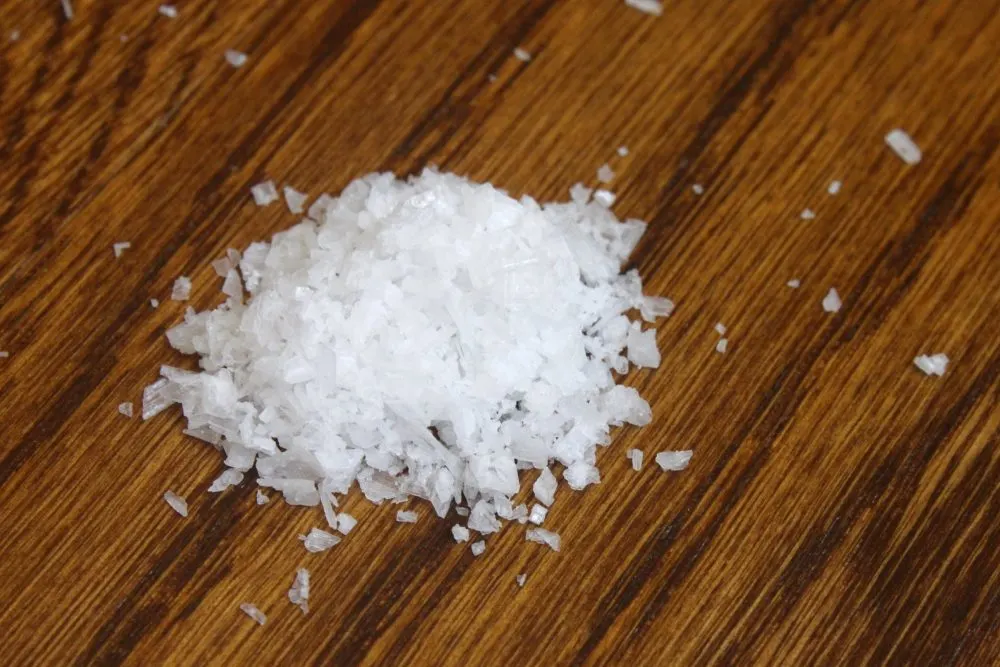Did you know that most of us vastly exceed the amount of sodium we should eat each day? This excess sodium intake is making us, as a general population, less healthy. The first step to reducing our sodium intake is understanding what our maximum intake should be and then making a plan to get below it.
The recommended maximum daily intake of sodium varies depending on the group making the recommendation. Below is a summary of the recommendations from the FDA, the American Heart Association, and the World Health Organization (WHO).(1-4)

Daily Sodium Intake Recommendations:
US Food and Drug Administration (FDA):
In May of 2016, the FDA updated its nutrition facts label requirements, including a slight reduction for the Upper Limit of sodium from 2400 mg per day to 2300 mg per day, to reflect the recommended upper limit of sodium from the Dietary Guidelines for Americans.(5,6)
For reference, one teaspoon of table salt contains approximately 2300 mg of sodium.y
The FDA recommendations are based on the Dietary Guidelines for Americans (more info below), but simplified for inclusion on the Nutritions Facts panel.
Dietary Guidelines for Americans:
Every five years, the US Department of Agriculture (USDA) and Department of Health and Human Services (HHS) update the nutritional goals in the Dietary Guidelines for Americans.
Below is a table outlining the current recommended daily maximum sodium intake, broken down by age.(6)
For readers in Canada, it is worth noting that Health Canada recommends the same values for maximum daily sodium intake.(8)

The maximum daily sodium intake, or upper limit, was set for sodium based upon the “increased risk of cardiovascular outcomes, particularly cardiovascular disease and stroke.”(6)
Lower daily sodium intake recommendations for children and adolescents are extrapolated down from the adult recommendation based on reduced daily energy (calorie) requirements.
American Heart Association (AHA):
The AHA has written two recent Presidential Advisory position papers, citing “the strength of the evidence relating excess sodium intake to high blood pressure, cardiovascular disease (CVD), and stroke” in developing their recommendations for daily sodium consumption.(2,3)
The AHA’s recommends that the entire population (children and adults alike) consume no more than 1500 mg of sodium each day because of “the capacity of reduced intake of sodium to prevent and treat hypertension and to reduce the risk of adverse CVD and stroke events.”(2)
As with added sugar, the AHA’s recommendation for sodium intake is the most restrictive recommendation of the three organizations.
World Health Organization (WHO):
Guidelines released by the WHO in 2012 advised that people should reduce the amount of salt they consume to less than 5 grams a day, which corresponds to less than 2 grams a day of sodium (< 2000 mg).(4)
This is the equivalent of a little less than one teaspoon of salt a day.(7)
For children, the maximum sodium consumption of 2 grams (2000 mg) a day should be scaled downward based on daily energy consumption. This means that if a child eats 1000 calories a day (~ half that of an average adult), they should consume no more than 1000 mg of sodium a day.
Final thoughts on sodium intake
Depending on the agency making the recommendation, the maximum recommended upper limit of sodium per day should be between 1500 to 2300 mg.
However, the majority of us consume well over this amount and it is affecting our health.
Personally, I am trying to limit our family’s daily sodium intake to somewhere between 1500 to 2000 mg a day. This means we try to limit eating out and prepare our meals from scratch, whenever possible.
When we eat prepared foods, I look for lower sodium options or mix them with no-salt added versions to reduce the sodium content.
References:
- Updated daily recommended values, FDA Federal Register, May 2016,§ 101.9(c)(9) (link )
- Sodium, Blood Pressure, and Cardiovascular Health, Further evidence supporting the American Heart Association Sodium Reduction Recommendations. Circulation. 2012;126:2880-2889 (link)
- The Importance of Population-Wide Sodium Reduction as a Means to Prevent Cardiovascular Disease and Stroke, A Call to Action From the American Heart Association. Circulation. 2011;123:1138-1143. (link)
- WHO Guideline: Sodium intake for adults and children, 2012 (link)
- Changes to the Nutrition Facts Label, FDA Website, 2016 (link)
- Dietary Guidelines for Americans, 2015-2020, Eighth Ed. (link)
- Morton Plain Table Salt Nutrition Facts, Morton Website (link)
- Sodium in Canada, Health Canada Website (link)
